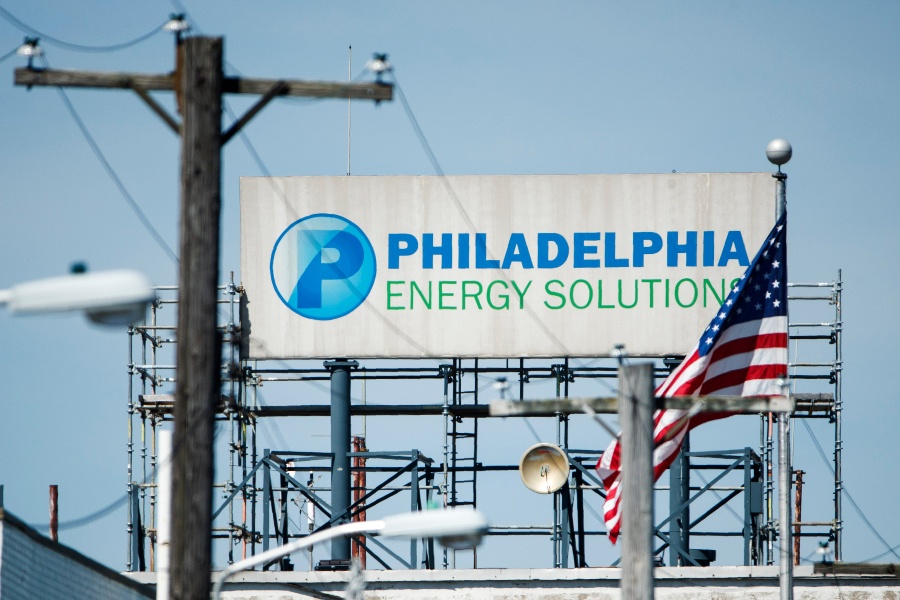The South Philly Refinery Explosion Was a Failure in City Transparency
By not acknowledging that concerning levels of a toxic chemical were released into the air, the administration failed residents. That's not acceptable.

(AP Photo/Matt Rourke)
We’ve relived the event over and over: On June 21st, the Philadelphia Energy Solutions refinery complex exploded and sent a blazing ball of fire and smoke into the sky. That day, reporters (like me) parked just south of the complex as first responders and emergency personnel provided updates. We opened our car doors to air that reeked of burnt chemicals and closed them as quickly as possible. As I drove home over the George C. Platt Memorial bridge hours after the incident, chips of blowing debris clanked against my car windows.
Four days later, Mayor Jim Kenney stood in a room full of reporters — again, myself included — and told the city that basically, everyone would be just fine: “There are no findings that would suggest a threat to public health.”
But in the months after the incident, the public would learn through sources other than the city that highly toxic and potentially deadly chemicals had been released into the atmosphere as a result of the explosion, which cost the city more than $1.8 million in response-staff time. Four months after Kenney’s press conference, federal investigators revealed that more than 5,200 pounds of hydrogen fluoride, a systemic poison that can harm lung and skin tissue and in some cases cause death, were released from the refinery during the incident.
Three months after that, a joint investigation by NBC News, E&E News, and the nonprofit Investigative Reporting Workshop dropped another bombshell, this time regarding the refinery’s emissions of benzene, a carcinogen that, if encountered at high levels over a long period of time, can cause leukemia, anemia, excessive bleeding, and immune system damage. In the weeks before and after the explosion, benzene levels on the refinery’s borders — not far from schools, homes, parks and businesses — tested at more than 21 times the federal limit, according to the report.
Journalists who visited the refinery complex on the day of the explosion stayed no longer than we thought necessary; you needed only basic instinct to know not to breathe that putrid air. But more than 113,000 Philadelphians live within one mile of the complex, built on what was once marsh and farmland. Seventy-seven percent of this population, which has long complained about the refinery’s health effects, is comprised of minorities, many of whom are low-income, according to the city. Lots of people had no choice but to be potentially exposed to whatever was released from the refinery that day. That they and other Philadelphians attained information about possible air pollution from sources other than city officials — who knew that benzene emissions in May had exceeded the EPA action level at the time of Kenney’s press conference, according to the NBC report — is disappointing. In declining to be transparent about possible threats to community safety, city officials failed residents.
Benzene and Air Monitoring
Benzene is, to some extent, an everyday chemical, typically present in close proximity to tobacco smoke, gas stations and car exhaust (and in indoor air thanks to glues, paints, waxes and detergents). The chemical compound has a colorless liquid form that evaporates very quickly. It’s one of those invisible chemical beasts that at high exposure levels can wreak havoc on the human body. Workers in industries that use it, such as oil refining, typically encounter the most dangerous levels, according to the CDC.
The now-shuttered PES, formerly the largest oil refinery complex on the East Coast, operated at least one unloading site, so it comes as no surprise that the carcinogen was present there. But the levels at which benzene was recorded on the refinery’s borders before and after the June explosion are alarming.
The Environmental Protection Agency’s benzene “action level” is nine micrograms per cubic meter of air. As of September, NBC News reported, the refinery’s annual average was 49 micrograms per cubic meter, or five times the EPA action level. PES disclosed to the EPA that in the weeks before and after the explosion, some of the monitors along the refinery’s borders repeatedly reached 190 micrograms per cubic meter, according to the investigation. Emission levels could actually have been higher than that: PES reported that the readings were so steep, they exceeded “instrument calibration range,” per the report.
To give you a sense of how drastic the findings were, Bob Sonawane, a former EPA toxicologist, told NBC News: “Oh, my God. The numbers that you’re saying are very, very high, like some things happening in China, India” — both of which house cities that record some of the highest levels of air pollution on Earth — “and many other places.”
City officials say they decided not to inform residents that benzene levels on the refinery’s borders had exceeded the EPA action limit because recorded levels didn’t represent an immediate threat to human health. In defending that reasoning, James Garrow, a spokesperson for the Philadelphia Department of Public Health, said a city-run air-monitoring station at 24th and Ritner streets, about a half mile from where the refinery’s highest benzene emissions were recorded, according to the report, didn’t detect such high levels.
Contacted by Philadelphia magazine this week, Garrow said benzene emissions at 24th and Ritner streets between May and September never reached a reporting threshold equivalent to the federal action level. Plus, he said, the EPA states that the action level doesn’t necessarily correlate to a benzene emissions level that presents a risk to the public.
“The City takes its duty to issue alerts for serious and significant risks to the public health extremely seriously,” Garrow said. “Part of that responsibility is only issuing alerts when there is a confirmed and present danger so the public continues to have faith in the warnings we issue.”
But Sonawane, the former EPA toxicologist, told NBC News that a hazard summary he worked on while at the EPA found that anyone exposed to air with more than .45 micrograms per cubic meter of benzene over their lifetime would have a greater than one in 1 million chance of developing cancer. That risk increases to more than 10 in 1 million at the federal action level, per the report. For that reason, he told the investigators, the action level is “not protective of public health.”
At a standing-room-only City Council meeting regarding the refinery in November, PES refinery advisory group chair and Philadelphia managing director Brian Abernathy suggested the city review its air monitoring capabilities “to make sure [they are] designed to accurately identify hazards and protect people from them.”
That officials would project trust in a system designed to protect residents and months later propose a review of that same system is troubling, especially considering that the system may not have been effective. Once evaporated, benzene moves with the wind — one of several factors that can affect air data results. Drexel University professor and air quality researcher Peter DeCarlo has noted that wind direction on the day of the PES explosion prompted the fire’s smoke plume to travel southwest of the refinery — not toward the 24th and Ritner monitoring station.
“There will likely be [an] increase in [hospital] admittance, or people going to the emergency room for respiratory issues who live downwind of this plume,” DeCarlo told Grid at the time.
Moving Forward
Despite claims that residents weren’t seriously affected by the explosion, City Councilmember Helen Gym said at the November 22nd meeting that her office fielded calls from residents — both on the day of the incident and weeks later — complaining about air quality and breathability in the area.
Abernathy said at the meeting, “I think we likely could have improved our communication immediately surrounding the incident.”
He’s right. From the beginning, officials should have revealed information about benzene emission levels at the edge of the refinery. That would have allowed residents to determine for themselves how comfortable they were living, working, playing and breathing in the air near the complex.
“It’s clear that the past is what it is,” then-Councilperson Blondell Reynolds Brown told Abernathy at the Council hearing in November. “And the question for us always is, ‘What are the lessons learned, and what do we take from this tragic incident, and how do we act differently going forward?'”
The city still has a chance to do better — in this, and in other crises that may come — as the fate of the PES site is determined this week in a U.S. bankruptcy court in Wilmington. PES is attempting to sell the property and maintains that it shouldn’t continue to be used as a refinery; union members and oil industry leaders have other ideas.
A site cleanup undertaken by former refinery complex owner Sunoco and Evergreen Resources Group, which is helping to conduct the remediation, includes a public engagement process. The city has pushed Sunoco and Evergreen to hold a public engagement meeting, but past plans have been canceled due to “protests,” Abernathy said.
“Again, we did not [hold such a meeting with Sunoco], and frankly, at the turn of the administration, we didn’t do a very good job of making sure that public engagement process happened,” Abernathy acknowledged in November. “We recognized that before the incident on the 21st, and we’re taking steps to remediate. … Obviously, we still need to do a better job and make sure that engagement process happens.”
Asked this week whether the city has made progress, Kenney administration spokesperson Mike Dunn said officials “have been working to find a path forward for a robust public involvement process that is acceptable to as much of the community as possible.”
Abernathy said in November that his advisory group was expected to make headway on two fronts: exploring the city’s ability to limit hydrogen fluoride on the refinery site moving forward, and reviewing its air-monitoring capacities. This week, the administration finally announced plans to introduce legislation that would ban hydrogen fluoride at all refineries in the city. As for air monitoring, Dunn said the city has conducted a review and has “begun to assess what additional monitoring capacity it could put in place if PES were to restart as a refinery. However, that assessment will not be complete until it is clear how the PES site will be used in the future.”
As of Thursday, it looks like PES will sell the site to a Chicago-based firm that has said it plans to demolish the refinery. Given what we know now, we should be relieved.


